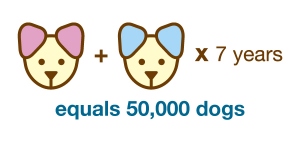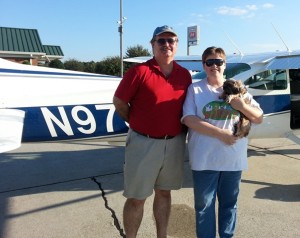August 30, 2014 / by Leann / Make A Comment / Filed under Uncategorized
 How many times have we humans heard the expression, “You’re only as old as you feel”? And why is it that some days, despite our actual age, we feel younger than we are, while other days, we feel older, much older?
How many times have we humans heard the expression, “You’re only as old as you feel”? And why is it that some days, despite our actual age, we feel younger than we are, while other days, we feel older, much older?
So it is with our canine companions. What constitutes a senior in one breed may be an adult in another – with plenty of room for peppiness in both. Although most veterinarians agree that a dog is considered “senior” around the age of 7, what matters more is the size, not the number. Small dogs mature slower, tend to live longer than large dogs, and become seniors later in life. Dogs weighing less than 20 pounds may not show signs of aging until they’re around 12. Fifty-pound dogs won’t seem older until they’re around 10, while the largest dogs start “showing their age” at around 8.
But if wisdom comes with age, so do benefits. And in the case of those lovingly dubbed “gray muzzles”, the benefits of adopting a senior dog are many. Think puppy at heart without the puppy problems. Because in adopting a senior dog, you CAN judge a book by its cover. What you see is what you get: a mature animal whose physique and persona are fully formed — no baby teeth to gnaw on your furniture, no yappy energy to wear you out – allowing you to see, within moments, if yours is a mutual match or not. Although, as with everything else, there are always exceptions to the rule, opening your home to an older dog means opening your heart to an experience akin to instant gratification.
Calmer than their younger counterparts, older dogs are house trained and have long since mastered the basic commands of “sit,” “stay,” “down,” and “come.” And contrary to popular belief, you CAN teach an old dog new tricks. Dogs are trainable at any age, and older dogs are just as bright as younger ones, with a greater attention span, making them that much easier to train. Older dogs are loyal, loving and experienced companions, ready to walk politely on leash with you, run gaily off leash (with good recall) in the dog park, and play frisky games of fetch with your new tennis ball or their own, well-worn one.
Less demanding of your attention than younger dogs, they are content with their own company for longer periods, then will lavish you with all of their adoration and affection when it’s cuddling time. Due to their lower energy level, senior dogs are easier to care for and make superlative companions for senior people. They also make friendly and gentle playmates for children — particularly if they were once some other family’s cherished pet.
One common misconception about older, adoptable dogs is that they are “problem dogs”. And yet, most of them have lost their homes, not because of their behavior or temperament, but because of changes in the lives, lifestyle or circumstances of their original owners.
Sadly, for many senior dogs awaiting adoption, age IS seen as a number, even if that number is only 5, and even if that same dog has 10 years or more to live, to love and be loved. More difficult to adopt than younger dogs, and just as deserving of a permanent home, they are all too often overlooked and for all the wrong reasons.
Senior dogs seem to sense when they receive a second chance at the rest of their lives. And anyone wise enough to adopt one, will not only reap the benefits, but will be the lucky recipient of a love as unconditional as it is enduring.
Author: Nomi Berger
August 29, 2014 / by Leann / Make A Comment / Filed under Uncategorized
Crossroads Shih Tzu Rescue is committed to helping shelter dogs, and so we when we saw the photos of the dogs we would call Domino and Zac in their kennels at Chicago Animal Care and Control, we new we had to get them out of there if at all possible. I mean, how could we pass up these faces?? Domino was an owner surrender whose owners said they just didn’t want him anymore. We cannot understand it because this boy is wonderful. Adorable Zac’s pleading face from his CACC kennel just about broke our hearts, and so we took him, too, once his stray hold was up. As you can see, both boys are doing fabulously after two weeks in their foster homes, and now they are ready to start looking for their forever homes. Their profiles will be up soon on our Petfinder page, and they will be available for adoption in the Chicago area.
Just look at these sweet boys!


August 27, 2014 / by Leann / Make A Comment / Filed under Uncategorized
 The problem of pet overpopulation is a global one and requires a solution on a global scale. But like every journey that begins with a single step, this particular journey must begin with every pet owner. Those who do their part and act responsibly by spaying and neutering their cherished family pets.
The problem of pet overpopulation is a global one and requires a solution on a global scale. But like every journey that begins with a single step, this particular journey must begin with every pet owner. Those who do their part and act responsibly by spaying and neutering their cherished family pets.
Spaying (removing the ovaries and uterus of a female dog) and neutering (removing the testicles of a male dog) are simple procedures, rarely requiring so much as an overnight stay in a veterinary clinic. Because half of all litters are unplanned, and because puppies can conceive puppies of their own, spaying and neutering them before the age of 6 months can help break this cycle.
According to SPAY USA, an unspayed female dog, her unneutered mate and their offspring (if none are spayed or neutered) result in the births of a staggering 12,288 puppies in just 5 years.
The inevitable outcome? Hundreds of thousands of dogs being euthanized through no fault of their own. Why? Because they are the tragic, but avoidable, result of over breeding and overpopulation. Why? Because there are too few shelters to house them and too few homes to either foster or adopt them. Why? Because there are still too many dog owners unwilling to spay and neuter their pets.
The positive effects of spaying and neutering far outweigh the negatives. Females spayed before their first heat are 16 times less likely to develop mammary cancer than those left intact. Early spaying is also their best protection against conditions like pyometritis, a potentially fatal bacterial infection of the uterus, as well as ovarian and uterine cancers. Early neutering of males protects them against testicular cancer, and helps curb both aggression and other undesirable behaviors. According to the American Veterinary Medical Association Task Force on Canine Aggression and Human-Canine Interactions, 70 to 76 percent of reported dog bite incidents are caused by intact males.
For years, reputable rescue groups have been spaying and neutering the animals in their care before even putting them up for adoption. More recently, in an effort to address at least part of this ongoing problem, various organizations — large and small, urban and rural, public and private — have been springing up across the country. From the ASPCA to local humane societies, spay/neuter clinics are opening and operating. Mobile spay/neuter clinics are reaching out to those unable to reach them. Many rescue groups now offer their own Spay Neuter Incentive Programs (SNIP), which provide assistance to low income households.
Imagine if there were more regional, local and mobile spay/neuter clinics. More Spay Neuter Incentive Programs. Imagine entire communities across the country, where every pet owner took personal responsibility for spaying and neutering their pets. Imagine what we, as part of the global community, could accomplish then.
Author: Nomi Berger
August 25, 2014 / by Leann / Make A Comment / Filed under Uncategorized
WILL YOU VOLUNTEER WITH US?
WE NEED ADDED HANDS AND ARDENT HEARTS!
WE are, therefore, reaching out to you and asking for your personal contribution to our rescue and our refuge.
 WE are asking for your compassion, your creativity and your commitment by joining our dedicated team of volunteers.
WE are asking for your compassion, your creativity and your commitment by joining our dedicated team of volunteers.
WE are asking you to set aside some time for us. To set your own agenda as you work with us.
WE are asking for your own unique voice, perspective and talent as you lend all three to our own unique organization.
THE more volunteers we have, the more we can accomplish, the more activities we can host, and the more funds we can raise.
THE more volunteers we have – including volunteer foster homes — the more lives of desperate and deserving, sick and senior dogs we can save.
THE more volunteers we have, the more power we have. The more power we have, the more chance we have of continuing to realize our rescue’s goals.
NO two volunteers are the same, but the experience of volunteering is. It can be one the most satisfying and fulfilling experiences of your life.
WON’T YOU ADD YOUR HANDS AND HEARTS TO OURS?
WE invite you to learn more about volunteering with us by visiting: www.crossroadsrescue.org or emailing us at: cstr.board@crossroadsrescue.org
August 23, 2014 / by Leann / Make A Comment / Filed under Uncategorized
 Why adopt a rescue pup or dog? Why not buy one from an ad on the Internet or from a pet store? Why not buy one from a breeder? There are many reasons — all of them humane.
Why adopt a rescue pup or dog? Why not buy one from an ad on the Internet or from a pet store? Why not buy one from a breeder? There are many reasons — all of them humane.
The growth of the Internet has spurred the growth of ads selling pets. But it also provides anonymity to a more insidious growth: that of puppy mills and so-called “backyard” breeders. It helps them avoid accountability when they sell unhealthy or mistreated pets to unsuspecting, over-eager buyers. And it only serves to confirm the axiom: “buyer beware.”
Each time a dog is bought from an ad on the Internet, a homeless dog is left without a home.
Many pet stores rely on both puppy mills and “backyard” breeders. Like the Internet, they rely on impulse buying. A child ogles a playful puppy through a pane of glass, and that old song, “How Much Is That Doggy in the Window?” begins. Few parents can refuse the insistent “Please! Please! Please!” of their children.
Each time a puppy is bought from a pet store, a surrendered dog languishes in a shelter.
There may be thousands of legitimate breeders throughout the country but there are just as many unscrupulous ones. There are no laws regulating who can and cannot breed. There are no inspections of their facilities. Even a certificate from a recognized kennel club means only that the breeder has “agreed” to its code of ethics. A piece of paper is simply that: a piece of paper.
Each time a dog is bought from an unscrupulous breeder, an abandoned dog moves closer to death in a pound.
Why, then, adopt a rescue dog?
There are tens of thousands of healthy, happy and balanced dogs available from thousands of rescue organizations across the country. Contrary to popular belief, they include purebreds as well as crossbreeds and mixed breeds. And for people intent on a specific breed, there are rescue groups devoted exclusively to a single breed of dog.
Adopting a rescue dog is saving that dog’s life. Rescue organizations are usually the last refuge for abandoned and abused dogs, surrendered and senior dogs. They are often a dog’s only escape from a puppy mill, shelter or pound. These rescued dogs are placed in loving and experienced, volunteer foster homes, where they are socialized with people and other animals.
They are spayed or neutered, de-wormed, updated on all of their vaccinations and microchipped. They receive whatever veterinary care they need, and are either trained or re-trained before being put up for adoption. And everything is included in the rescue’s modest adoption fees.
It is said that saving a dog makes that dog doubly grateful. By extension, then, anyone who saves a dog will be doubly blessed.
What better reasons could there be to adopt?
Article written by Nomi Berger. Nomi is the best selling author of seven novels, one work of non-fiction, and two volumes of poetry. She lives in Toronto, Ontario, Canada and now devotes all of her time volunteering her writing skills to animal rescue organizations throughout Canada and the USA.
 How many times have we humans heard the expression, “You’re only as old as you feel”? And why is it that some days, despite our actual age, we feel younger than we are, while other days, we feel older, much older?
How many times have we humans heard the expression, “You’re only as old as you feel”? And why is it that some days, despite our actual age, we feel younger than we are, while other days, we feel older, much older?






